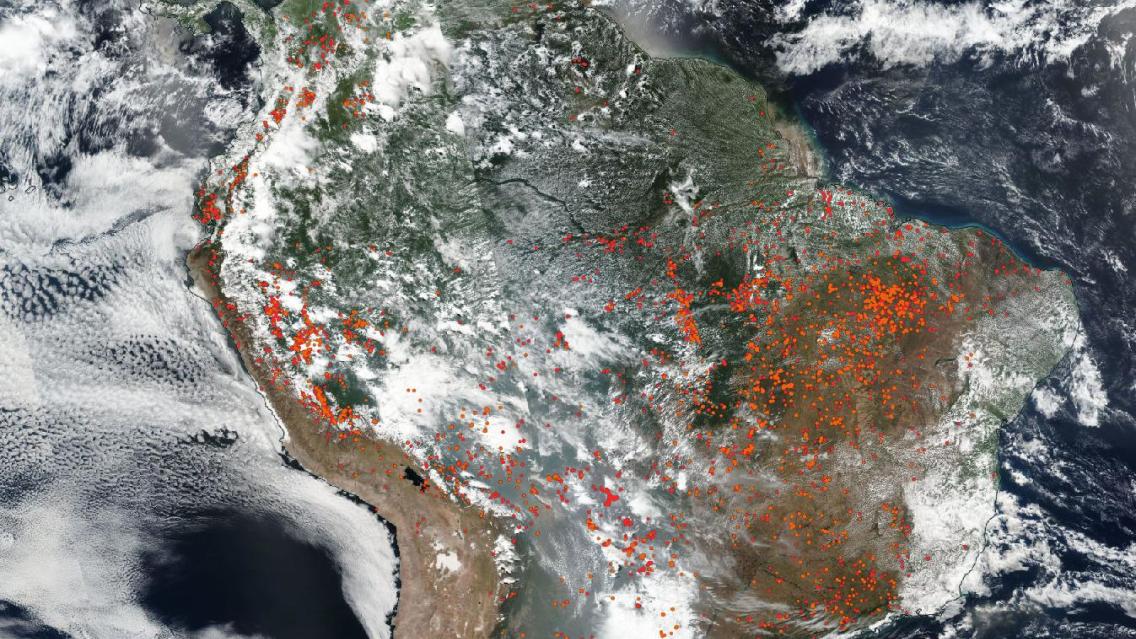Managing fire risk in the Amazon ahead of an El Nino year

The Amazon Rainforest, often referred to as the "lungs of the Earth," plays a vital role in global climate regulation and biodiversity preservation. However, this precious ecosystem faces numerous threats including deforestation and the increasing frequency of wildfires driven by long-term climate change and shorter-term climate variability. One significant contributor to the intensification of Amazon fire risk is the El Niño phenomenon, which usually exacerbates dry conditions. SERVIR, a NASA and USAID partnership, supports specialized forecasts (subseasonal to seasonal forecasts) as invaluable tools to better predict and mitigate these risks.
The Impact of El Niño on the Amazon
El Niño is a climate phenomenon characterized by the periodic warming of sea surface temperatures in the equatorial Pacific Ocean. This warming can lead to a cascade of effects all over the world, including shifts in rainfall patterns and temperatures. In the case of the Amazon, El Niño tends to bring drier and hotter conditions. As a result, the rainforest becomes more susceptible to wildfires, which can lead to devastating consequences for both the environment and local communities.
The Importance of Subseasonal to Seasonal Forecasts
Global climate models have proven to offer skillful predictions of the development of El Niño. Their subseasonal to seasonal (S2S) forecasts provide essential insights into weather and climate patterns on time scales ranging from a few weeks to several months. In the context of the Amazon, these forecasts offer a crucial window of opportunity to prepare for the increased fire risk associated with El Niño events. By knowing when and where dry conditions are likely to occur, authorities and organizations can take proactive measures to reduce the impact of wildfires.
CEMADEN and SERVIR Collaboration
The Center for Monitoring and Early Warning of Natural Disasters (CEMADEN) in Brazil recognized the importance of S2S forecasts for fire risk prediction and reached out to the SERVIR Applied Sciences Team, (AST), led by Dr. Benjamin Zaitchik at the Johns Hopkins University. Dr. Zaitchik has expertise in using NASA's state-of-the-art Land Data Assimilation System (LDAS) data and models for Earth science applications that help us mitigate and adapt to climate change.
In response to CEMADEN's request, Johns Hopkins postdoctoral researcher Dr. Prakrut Kansara used NASA's GEOS S2S forecast model to predict rainfall and temperature in the Amazon. Dr. Kansara mapped where conditions were likely to be above or below normal. CEMADEN used this critical information in combination with their own fire forecasting techniques to generate fire risk hazard maps for all of Brazil -- giving decision makers actionable risk information about the future.
The Fire Risk Report for Brazil
The hazard maps, developed with the assistance of SERVIR, were integrated into a comprehensive fire risk report prepared by CEMADEN at the request of Brazil's presidential office. This report offered a detailed assessment of the fire risk conditions across the country, taking into account the current and projected El Niño conditions. The report equipped policymakers, land managers, and emergency responders with the data needed to inform decisions about fire prevention, firefighting efforts, and community safety. By leveraging S2S forecasts and probability maps, the report is a valuable resource for proactively addressing the heightened risk of wildfires in the Amazon and other vulnerable areas.
The impact of El Niño on the Amazon rainforest is a serious and recurring concern, and it underscores the urgency of predicting and mitigating wildfire risks. Collaborations like the one between CEMADEN in Brazil and SERVIR demonstrate the value of subseasonal to seasonal forecasts in early warning systems for Amazon fire risk. By harnessing the power of science, technology, and international collaboration to make earlier decisions, we can work towards preserving the Lungs of the Earth that is the Amazon.

